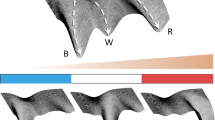Abstract
Catastrophe theory can be used to illustrate the results of some of the events that occur during embryogenesis. Trajectories over the surface of catastrophe manifolds provide an extension of Waddington's concept of a description of embryogenesis based on chreodic paths on an epigenetic landscape. The development of Elementary Catastrophe Theory to describe time- and spece-equivalent events provides a rich qualitative “language” that seems well suited for the description of cellular behavior. Space-equivalent catastrophes have been used to illustrate the processes of cellular determination, differentiation, and transdetermination with initial success. This use should be tested further, for example, by experimental manipulation of embryonic tissue at well defined intervals of time during its development. The relationship of this approach to some others and to possible future theoretical developments has been discussed.
Similar content being viewed by others
Literature
Bennett, D., E. A. Boyse, and L. J. Old. 1972. “Cell Surface Immunogenetics in the Study of Morphogenesis.” InCell Interactions. Third Lepetit Colloquium pp. 247–263.
Cooke, J. 1975. “The Emergence and Regulation of Spatial Organization in Early Animal Development.”Appendix, Zeeman, E. C.: Catastrophe Theory and Biological Patterns.Ann. Rev. Biophys. Bioengng,4, 185–217.
Child, C. M. 1941.Patterns and Problems of Development. Chicago, Ill.: University of Chicago Press.
Deuchar, E. M. 1973. “Biochemical Aspects of Early Differentiation in Vertebrates.”Adv. Morph.,10, 175–225.
Flawiá, M. and H. N. Torres. 1973. “Adenylate Cyclase Activity inNeurospora crassa. III. Modulation by Glucagon and Insulin.”J. Biol. Chem.,248, 4517–4520.
Furshpan, E. G. and D. D. Potter. 1968. “Low Resistance Junctions between Cells in Embryos and Tissue Culture.”Curr. Topics Dev. Biol.,3, 95–127.
Gardner, R. and M. Lyon. 1971. “X Chromosome Inactivation Studied by Injection of a single Cell into the Mouse Blastocyst.”Nature,231, 385–386.
Gehring, W., G. Mindek and E. Hadam. 1968. “Auto- und Allotypische Differenzierungen aus Blastemen der Halterenscheibe vonDrosophila melanogaster nach Kulturin vivo.”J. Embryol. Exp. Morph.,20, 307–318.
Godwin, A. N. 1971. “Three dimensional pictures for Thom's parabolic umbilic.”Inst. Hautes Études Sci. Publ. Math.,40, 117–138.
Goodwin, B. C. and M. H. cohen. 1969. “A phase shift model for the spatial and temporal organization of developing systems.”J. Theor. Biol.,25, 49–107.
Gurdon, J. B. 1974.The Control of Gene Expression in Animal Development. Cambridge, Mass.: Harvard University Press.
Hadorn, E. 1966. “Konstanz, Wechsel und Typus der Determination und Differenzierung in Zellen aus Männlichen Genitalan Lagen vonDrosophila melanogaster nach Dauerkulturin vivo.”Dev. Biol.,13, 424–509.
Harris, H. 1974.Nucleus and Cytoplasm. 3rd ed. Oxford: Oxford University Press.
Holmes, P. J. and D. A. Rand. 1976. “The Bifurcations of Duffing's Equation: an Application of Catastrophe Theory.”J. Sound Vibration,44 (2), 237–253.
Huxley, T. E. and G. deBeer. 1934.The Elements of Experimental Embryology. New York: Macmillan.
Illiano, G., G. P. E. Tell, M. I. Siegel, and P. Cuatrecasas. 1973. “Guanosine 3′: 5′-Cyclic Monophosphate and the Action of Insulin and Acetylcholine.”Proc. Natn. Acad. Sci. U.S.A.,70, 2443–2447.
Insel, P. A., H. R. Bourne, P. Coffino, and G. M. Tomkins. 1975. “Cyclic AMP-Dependent Protein Kinase: Pivotal Role in Regulation of Enzyme Induction and Growth.”Science,190, 896–898.
Kauffman, S. 1975. “Control Circuits for Determination and Transdetermination: Interpreting Positional Information in a Binary Epigenetic Code.” In:Cell Patterning. CIBA Foundation Symposium29 (new series). Amsterdam, Holland: Associated Scientific Publishers.
Kram, R., P. Mamont and G. M. Tomkins. 1973. “Pleiotypic Control by Adenosine 3′:5′-Cyclic Monophosphate: A Model for Growth Control in Animal Cells.”Proc. Natn. Acad. Sci. U.S.A.,70, 1432–1436.
Kram, R. and G. M. Tomkins. 1973. “Pleiotypic Control by Cyclic AMP: Interaction with Cyclic GMP and Possible Role of Microtubules.”Proc. Natn. Acad. Sci. U.S.A.,70, 1659–1663.
Lawrence, P. A., F. H. C. Crick and M. Munro. 1972. “A Gradient of Positional Information in an Insect,Rhodnius.”J. Cell Sci.,11, 815–53.
Lewin, R., 1973. New role for insulin.New Scientist, 690–692.
Needham, J. 1968.Order and Life. Cambridge, Mass: M.I.T. Press.
Sheridan, J. D. 1966. “Electrophysiological Study of Special Connections between Cells in the Early Chick Embryo.”J. Cell. Biol.,31 c1-c5.
Sheridan J. D. 1973. “Functional Evaluation of Low Resistance Junctions: Influence of Cell Shape and Size.”Am. Zool.,13, 1119–1128.
Tarkowski, A. and J. Wroblewska 1967. “Development of Blastomeres of Mouse Eggs Isolated at the 4- and 8-cell stage.”J. Embryol. Exp. Morph.,18, 155–180.
Thom, R. 1969. “Topological Models in Biology.”Topology,8, 313–335.
Thom, R. 1975.Structural Stability and Morphogenesis. Reading, Mass.: Benjamin.
Thompson, D'Arcy W. 1942.On Growth and Form. Cambridge, England: Cambridge University Press; New York: Macmillan.
Trelstad, R. L., E. D. Hay and J. P. Revel. 1967. “Cell Contact During Early Morphogenesis in the Chick Embryo.”Dev. Biol.,16, 78–106.
Waddington, C. H. 1940.Organizers and Genes. Cambridge: Cambridge University Press.
Waddington, C. H. 1970. “Concepts and Theories of Growth, Development, Differentiation and Morphogenesis.” In.Toward a Theoretical Biology: 3 Drafts (Waddington, C. H., Ed.) Chicago, Ill.: Aldine-Publishing Co.
Waddington, C. H. 1972.Towards a Theoretical Biology: 3 Essays (Waddington, C. H., Ed.) Chicago, Ill.: Aldine-Atherton Publishing Co.
Waddington, C. H. 1975.The Evolution of an Evolutionist. Ithaca, New York: Cornell University Press.
Wassermann, G. 1975. “Stability of Unfoldings in Space and Time.”Acta Math. 135, 57–128.
Wolpert, L. 1968. “The French-Flag Problem.” In,Towards a Theoretical Biology, I. Prolegomena. (Waddington, C. H. Ed.). pp. 125–133.Edinburgh University Press.
Wolpert, L. 1969. “Positional Information and the Spatial Pattern, of Cellular Differentiation.”J. Theor. Biol.,25, 1–47.
Wolpert, L. 1971. “Positional Information and Pattern Formation.”Curr. Top. Dev. Biol.,6, 183–224.
Wolpert, L. 1975. “The Development of Pattern: Mechanisms Based on Positional Information.”Adv. Chem. Phys.,29, 253–267.
Woodcock, A. E. R. 1978. “Cellular Differentiation and Catastrophe Theory.”Ann. N.Y. Acad. Sci.,231, 60–76.
Woodcock, A. E. R. 1978. “On the Geometry of Space- and Time-Equivalent Unfoldings.” Bull. Math. Biol.,40, 1–25.
Woodcock, A. E. R. and T. Poston. 1974.A Geometrical Study Of the Elementary Catastrophes.Lectures in Mathematics 373. New York: Springer-Verlag.
Zeeman, E. C. 1974. “Primary and Secondary Waves in Developmental Biology: InLectures on Mathematics in the Life Sciences,7, 69–161.
Author information
Authors and Affiliations
Rights and permissions
About this article
Cite this article
Woodcock, A.E.R. Catastrophe theory and cellular determination, transdetermination and differentiation. Bltn Mathcal Biology 41, 101–117 (1979). https://doi.org/10.1007/BF02547928
Received:
Issue Date:
DOI: https://doi.org/10.1007/BF02547928




